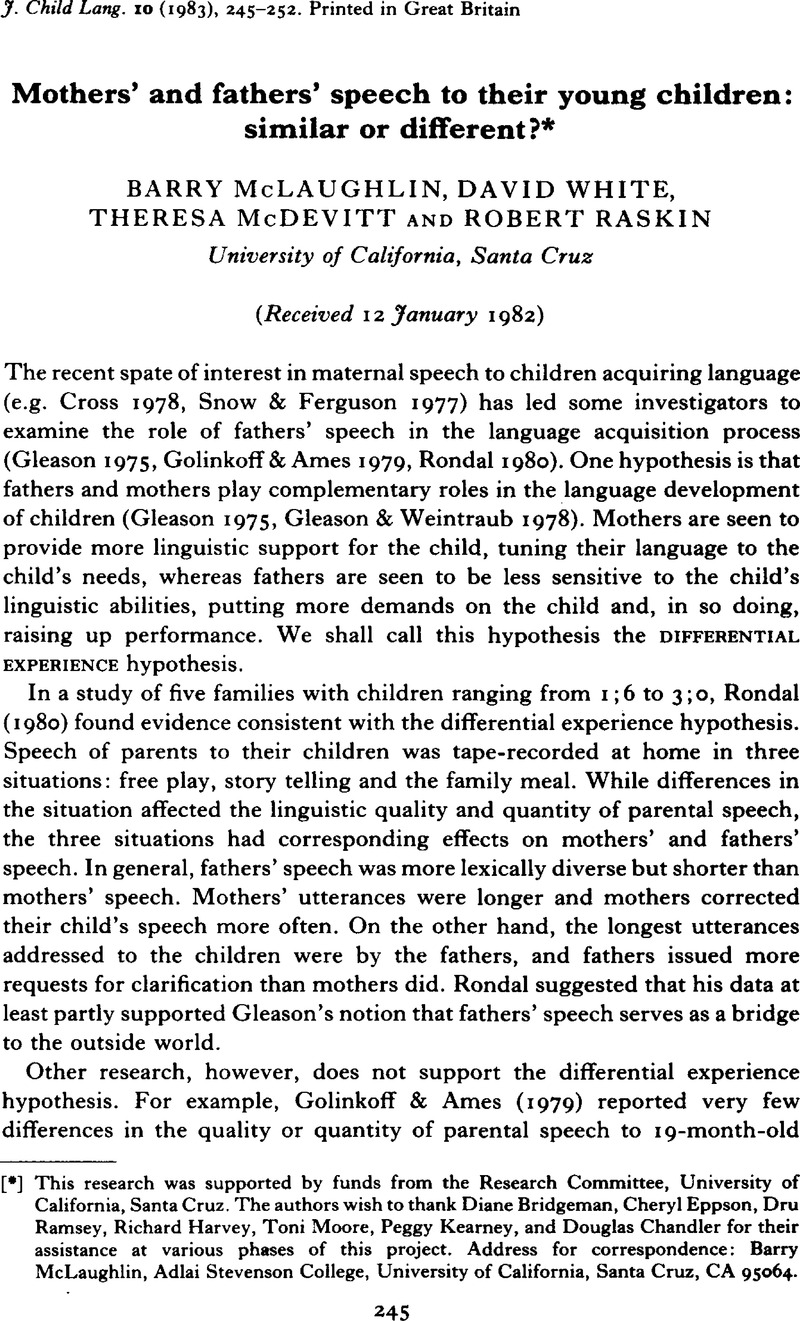Crossref Citations
This article has been cited by the following publications. This list is generated based on data provided by Crossref.
Beaudichon, Janine
1985.
La communication.
p.
137.
Lewis, Charlie
and
Gregory, Susan
1987.
Parents'talk to their infants: the importance of context.
First Language,
Vol. 7,
Issue. 21,
p.
201.
Nwokah, Evangeline E.
1987.
Maidese Versus Motherese — Is The Language Input of Child and Adult Caregivers Similar?.
Language and Speech,
Vol. 30,
Issue. 3,
p.
213.
Papoušek, Mechthild
Papoušek, Hanuš
and
Haekel, Monika
1987.
Didactic adjustments in fathers' and mothers' speech to their 3-month-old infants.
Journal of Psycholinguistic Research,
Vol. 16,
Issue. 5,
p.
491.
Brachfeld-Child, Sheila
Simpson, Tracy
and
Izenson, Nancy
1988.
Mothers' and fathers' speech to infants in a teaching situation.
Infant Mental Health Journal,
Vol. 9,
Issue. 2,
p.
173.
Ratner, Nan Bernstein
1988.
Patterns of parental vocabulary selection in speech to very young children.
Journal of Child Language,
Vol. 15,
Issue. 3,
p.
481.
Fernald, Anne
Taeschner, Traute
Dunn, Judy
Papousek, Mechthild
de Boysson-Bardies, Bénédicte
and
Fukui, Ikuko
1989.
A cross-language study of prosodic modifications in mothers' and fathers' speech to preverbal infants.
Journal of Child Language,
Vol. 16,
Issue. 3,
p.
477.
Tomasello, Michael
Conti-Ramsden, Gina
and
Ewert, Barbara
1990.
Young children's conversations with their mothers and fathers: differences in breakdown and repair.
Journal of Child Language,
Vol. 17,
Issue. 1,
p.
115.
Gallaway, C.
Hostler, M. E.
and
Reeves, D.
1990.
Speech addressed to hearing-impaired children by their mothers.
Clinical Linguistics & Phonetics,
Vol. 4,
Issue. 3,
p.
221.
Bornstein, Marc H.
Vibbert, Martha
Tal, Joseph
and
O'Donnell, Kim
1992.
Toddler language and play in the second year: stability, covariation and influences of parenting.
First Language,
Vol. 12,
Issue. 36,
p.
323.
Girolametto, Luigi
and
Tannock, Rosemary
1994.
Correlates of Directiveness in the Interactions of Fathers and Mothers of Children With Developmental Delays.
Journal of Speech, Language, and Hearing Research,
Vol. 37,
Issue. 5,
p.
1178.
Alexander, Kristin J.
Harkins, Debra A.
and
Michel, George F.
1994.
Sex Differences in Parental Influences on Children's Story-Telling Skills.
The Journal of Genetic Psychology,
Vol. 155,
Issue. 1,
p.
47.
Le Chanu, Mila
and
Marcos, Haydée
1994.
Father-child and mother-child speech: A perspective on parental roles.
European Journal of Psychology of Education,
Vol. 9,
Issue. 1,
p.
3.
Laakso, Marja-Leena
1995.
Mothers' and fathers' communication clarity and teaching strategies with their school-aged children.
Journal of Applied Developmental Psychology,
Vol. 16,
Issue. 3,
p.
445.
Marcos, Haydée
1995.
Mother‐child and father‐child communication in the second year: A functional approach.
Early Development and Parenting,
Vol. 4,
Issue. 2,
p.
49.
Walker, K
and
Armstrong, L
1995.
Do mothers and fathers interact differently with their child or is it the situation which matters?.
Child: Care, Health and Development,
Vol. 21,
Issue. 3,
p.
161.
Leaper, Campbell
and
Gleason, Jean Berko
1996.
The Relationship of Play Activity and Gender to Parent and Child Sex-typed Communication.
International Journal of Behavioral Development,
Vol. 19,
Issue. 4,
p.
689.
Lewis, Charlie
Kier, Cheryl
Hyder, Christina
Prenderville, Nancy
Pullen, Judith
and
Stephens, Annabella
1996.
Observer Influences on Fathers and Mothers: An Experimental Manipulation of the Structure and Function of Parent – Infant Conversation.
Early Development and Parenting,
Vol. 5,
Issue. 1,
p.
57.
Davidson, Rosalind G.
and
Snow, Catherine E.
1996.
Five-year-olds' interactions with fathers versus mothers.
First Language,
Vol. 16,
Issue. 47,
p.
223.
Tenenbaum, Harriet R.
and
Leaper, Campbell
1997.
Mothers' and Fathers' Questions to Their Child in Mexican-Descent Families: Moderators of Cognitive Demand During Play.
Hispanic Journal of Behavioral Sciences,
Vol. 19,
Issue. 3,
p.
318.



